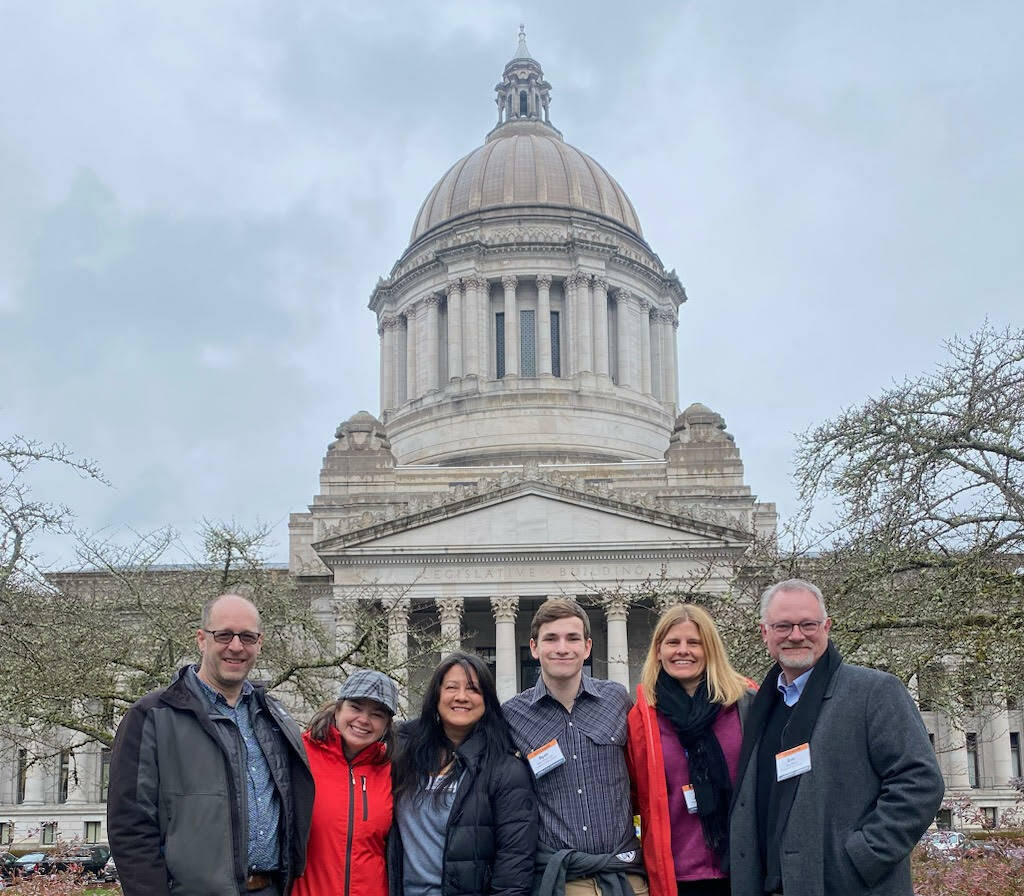by Toby Cooper
Sounder contributor
By his own admission, Ryan Krisch-Derr, Orcas High School Class of 2023, was gripped by uncertainty, fear and perhaps a spoonful of dread as he, four members of the Orcas School Board and Superintendent Eric Webb arrived in Olympia.
“I had no idea what to expect,” said Krisch-Derr, Orcas Island’s first-ever student to serve directly on the school’s governance board.
Their mission: to lobby Washington’s government for money. Statewide, Washington’s public schools support a K-12 population of just over 1 million students scattered throughout the state’s 295 school districts. In February, a portion of these districts converged on Olympia to meet with the state legislature, the governor and the Office of Superintendent of Public Instruction.
“Every year, we go to Olympia for a ‘Day on the Hill’ organized by school boards across the state,” says board member Bridget Broderick. “We come together for a common cause,” which most often means overcoming some form of budget shortfall.
For Krisch-Derr, the Day on the Hill became a moment in student life that no classroom can replicate. It was simultaneously a crash course in civics, a major in political science and a minor in public finance. He stifled fear and spoke with confidence, earning praise at the February School Board meeting the next day.
“Everyone wanted me to talk,” he said.
School board member Ayn Gailey sees the paradox of life in the world’s richest nation, at the height of the information age, where society’s most basic need for education is constantly starved for resources.
“For example, the state mandates that we must provide for the needs of Special Education – ‘SPED’ – students, yet there is no budget for it,” she said, noting that in San Juan County we spend about $500,000 – or some 4% – out of our general fund to close the deficit. “The state says they fully fund education. But most districts have to be creative and find money for a lot of what we do.”
Thus, SPED became one-half of the focus of this year’s Day on the Hill, with the other half being student transportation and transportation infrastructure. The combined Orcas, San Juan, Lopez and Shaw school board delegations were welcomed in District 40’s legislative offices of Senator Liz Lovelett, and Representatives Debra Lekanoff and Alex Ramel.
Later, when the groups met with State Superintendent of Public Instruction Chris Reykdal — himself a self-confessed father of two “smart, talented, and hilarious” teenagers — Krisch-Derr raised an unusual argument in support of enhanced SPED funding. He noted that when teachers are confronted with violence on the part of SPED students, they may be “afraid to report it,” leading to uncomfortable situations that could be softened with more supportive programs.
Broderick explained two additional issues of unique concern to island-based school systems like those in San Juan County. The first, known as the 2018 “regionalization rate,” concerns a state-applied formula for the funding a school district receives based on statistical metrics of housing costs. The resulting calculation imposes a ceiling for school support.
“However, the legislators decided to ignore the waters that separate the mainland from island districts,” she said. “Therefore, San Juan County was ‘regionalized’ with mainland districts such as Mount Vernon where housing is cheaper, pulling down the averages and unfairly crimping island school budgets.”
Broderick insists that the regionalization rate needs to be re-calculated more fairly to enable our island schools to afford, retain and recruit teachers.
Broderick, on behalf of Orcas and the companion school boards from San Juan, Lopez, and Shaw, has posted a petition in support of reform legislation here: https://chng.it/LrSCzjWhD9.
At press time, the Stand Together With Our Island Schools petition showed 1014 signatures. More are needed. Board and students alike offer sincere thanks for the community support.
Finally, the voters of Orcas, San Juan and Lopez have consistently voted to pass levies to help our schools. According to Broderick, these approved levy funds hold promise for the future of school funding. However, new state legislation has imposed “levy lids” which prevent the school district from accessing the funds our voters approved. As an example, the current levy lid for schools in the San Juan Islands is capped at $2,741 per student. Seattle Public Schools receive $3,290 per student, a difference of $549. Lifting the levy lid could increase our school districts and revenue by upwards of $436,754 per year.
And what is the likelihood of success? Broderick was “really proud of the efforts,” noting that this was the first time all three island districts worked together. She feels most optimistic about SPED; likewise for transportation, although the amounts in the bill are still shy of the actual need. She acknowledges the outcomes for regionalization and the levy lift are less certain.



